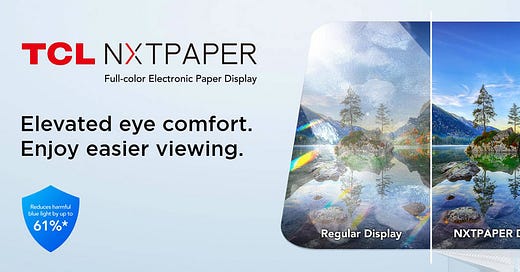Tablets with an etched anti-glare coating: Can they be an alternative to e-readers?
Can NXTPAPER be an alternative to E Ink?
There has been a trend of manufacturers releasing tablets with multiple layers built into the display and topped by an anti-glare coating to eliminate reflections and reduce blue light emission. The trend began with TCL releasing NXTPAPER, which claims to filter blue light through built-in layers that are topped with an anti-glare coating, producing a paper-like viewing experience:
The built-in matte layer, featuring nano-etching technology, significantly reduces light reflection, providing a paper-like viewing experience that enables users to read or watch content outdoors without distracting reflections.
Our innovative multi-layer blue light filtration technology prevents eye fatigue at the hardware level. Unlike other LCD screens with low blue light software solutions that often result in unpleasant yellowing, the TCL NXTPAPER display ensures you see true-to-life colors.
The first device TCL released with the technology was NXTPAPER Tab 10s. This was followed by NXTPAPER Tab 11, with the next generation NXTPAPER 2.0, which increases brightness and decreases blue light emission. Other than Tab 11, TCL released the larger Windows 11 two-in-one tablet (TCL NXTPAPER Book X12 Go) and NXTPAPER 12.0 Pro that similarly used NXTPAPER 2.0.
TCL announced NXTPAPER 3.0 as a further upgrade. TCL claims NXTPAPER 3.0 brings further blue light reduction, deeper contrast and the introduction of CPL (Circularly Polarized Light):
Building on the successful eye-care TCL NXTPAPER technology that is filtering harmful blue light by up to 61% while retaining sharp images, vibrant colors, deep contrast and the natural motion, TCL NXTPAPER 3.0 keeps these important benefits and introduces a range of features optimized for the senses of sight and touch. The central innovation is the introduction of the CPL (Circularly Polarized Light) screen, which simulates the "emission - reflection – refraction" path of natural light. This produces a visual effect that closely mirrors the experience of reading books in natural light, improving the screen’s paper-like appearance and providing additional eye comfort. Bolstering this innovation, TCL NXTPAPER 3.0 also boasts higher refresh rates and DC dimming technology to ensure a flicker-free viewing experience across all scenarios. Additionally, the newly improved Adaptive Color Temperature feature, powered by an RGB sensor, allows the TCL NXTPAPER display to automatically adjust and provide the most suitable color temperature based on time and ambient light. This guarantees a comfortable viewing experience, anytime, anywhere.
TCL released budget smartphones (TCL 40 NXTPAPER & 40 NXTPAPER 5G), TAB 10 NXTPAPER 5G, and a larger NXTPAPER Tab 14 Pro, all of which use NXTPAPER 3.0.
Like TCL, Huawei also released an anti-glare tablet with low blue light and flicker-free certification (Huawei MatePad 11.5-inch PaperMatte Edition). Oddly, Huawei released a slightly smaller 11-inch version of PaperMatte Edition that was less widely available. Nano-level anti-glare etching technology is similarly advertised to emphasise the matte coating built into the display. Lenovo followed Huawei, releasing a matte version of Tab P12.
A built-in anti-glare layer is not the same as installing a matte screen protector on a glossy screen. The anti-glare etching technology ensures better contrast and clarity. As a result, it is an antidote to matte screen protectors that often compromise clarity by generating a layer of graininess and are less effective in eliminating reflections.
An alternative to E Ink?
Regardless of certification, these devices are still backlit. Removing most reflections and reducing the blue light will help alleviate eye strain, but they are not a substitute or similar to E Ink, which is an e-paper technology. If it is not an alternative to E Ink or can be categorised as an e-paper solution, is there any purpose to the technology? As E Ink monitors and Android e-notes are restricted in the tasks they can be used for, something like NXTPAPER can be an eye-friendly option for productivity.
TCL and Huawei added further software features to make the screen more eye-friendly for reading. Both have an e-book mode that allows users to mute colours or turn the screen monochrome, making viewing the display less stimulating. The anti-reflective layer built into the display eliminates nearly all reflections, making dark mode less distracting and straining for reading and word processing.
Currently, there are a restricted number of tablets with built-in layering to the screen. Huawei MatePad 11.5-inch PaperMatte Edition, with its 11.5-inch screen, is one of the better productivity choices as it is bundled with a keyboard case and stylus. TCL's NXTPAPER Book X12 Go is another possibility, as it is a 12.5-inch Windows 11 two-in-one tablet. Unfortunately, it is configured with an underpowered processor (Snapdragon 7c) for Windows 11 and costs more than the Huawei MatePad 11.5-inch PaperMatte Edition.
Being more relaxing to view, introducing layered matte displays to reduce reflection and blue light is a positive trend. For electronic reading, E Ink remains the optimal solution. There have been some niche RLCD tablets, but large manufacturers have not adopted them to turn them into viable, refined products. It would be interesting to see the multiple-layered matte screen technology extended to monitors and laptops. Another possibility would be the use of the technology with AMOLED displays. Using AMOLED with NXTPAPER could result in a more comfortable viewing, as it is a display technology that does not emit light with blacks.




